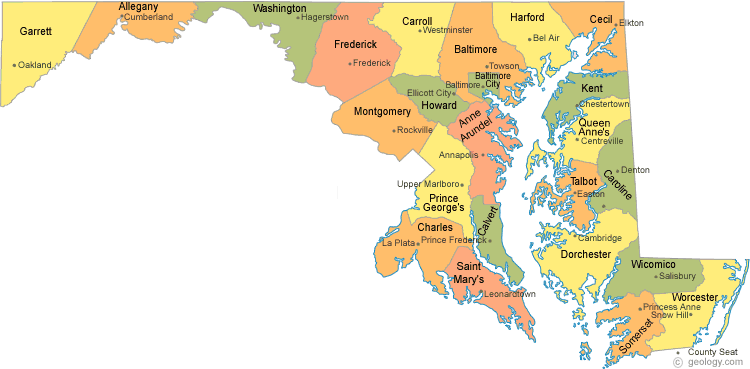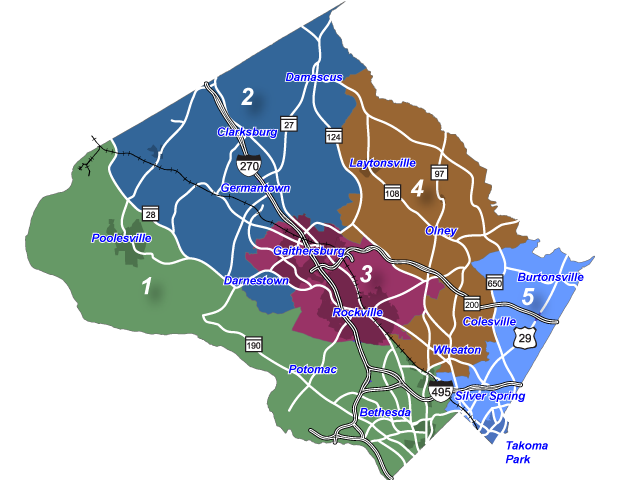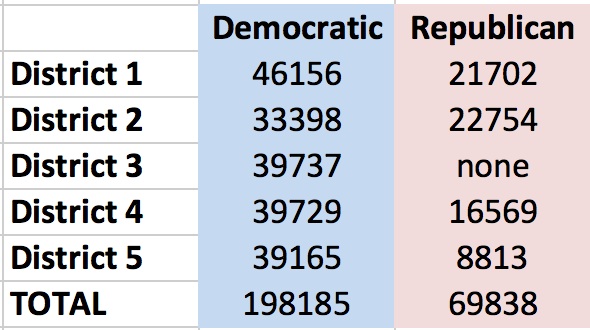
Maryland counties use a number of different methods to elect their county legislatures (see below for a description of how each county conducts its elections). The rules of the electoral game influence the outcome, as at-large elections facilitate one-party sweeps.
Twelve counties elect their councils entirely at-large throughout the county. The number will decline to eleven when Frederick elects its first charter government this year. Cecil and Garrett have district residency requirements for candidates but still elect them at-large. Cecil also staggers its elections.
Nine of the twelve counties with solely at-large elections have legislatures with members from only one party. In the remaining three, there is only one minority (Democratic) representative. (Of course, Kent has only three commissioners so the minority has to consist of only one commissioner.)
Eight counties elect their councils entirely from single-member districts. Districts can help with compliance with the Voting Rights Act by preventing the submergence of minorities among larger minority populations. Worcester County, for example, has a black district that resulted from voting rights litigation.
Districts also facilitate minority party representation. Only two of the eight counties elected entirely by district have single-party governments. Districts enable minority party representation so long as the minority comprises a majority within one of the districts. Minorities can still fail to win representation if their support is evenly distributed or just too weak, as in Carroll and Prince George’s Counties.
Three counties and Baltimore City elect their legislatures via a mixture of single-member districts and at-large. Baltimore City and Harford elect all councilmembers from districts except the city/county council president. Frederick will adopt Wicomico’s system of five from districts and two at-large when it elects its first charter government this year.
Uniquely, Montgomery elects four at-large in addition to five from districts. In this populous county, at-large councilmembers represent significantly more people than Members of Congress. And even the district councilmembers have roughly 200,000 constituents.
Among counties with mixed systems, heavily Democratic Baltimore City and Montgomery County have entirely Democratic councils. Harford and Wicomico have Republican majority counties with Democratic minorities.
Next Up: Ideas for creating more competition in Montgomery.
ALL ELECTED AT-LARGE
Allegany: three commissioners.
Calvert: five commissioners.
Caroline: three commissioners.
Cecil: five councilmembers. There are five districts and residency requirements but county voters elect all five. Elections are staggered so that the election of two coincides with the presidential election and three with the gubernatorial election.
Charles: five commissioners.
Frederick: five commissioners (through 2010).
Garrett: three commissioners. There are three districts and residency requirements but county voters elect all at-large.
Kent: three commissioners.
Queen Anne’s: five commissioners.
St. Mary’s: five commissioners.
Talbot: five councilmembers.
Washington: five commissioners.
ALL ELECTED FROM DISTRICTS
Anne Arundel: seven councilmembers.
Baltimore County: seven councilmembers.
Carroll: five commissioners.
Dorchester: five councilmembers.
Howard: five councilmembers.
Prince George’s: nine councilmembers.
Somerset: five commissioners.
Worcester: seven commissioners.
MIXED
Baltimore City elects 14 councilmembers from districts and the city council president at-large.
Starting in 2014, Frederick will elect five councilmembers from districts and two at-large.
Harford elects six councilmembers from districts and the council president-large.
Montgomery elects five councilmembers from districts and four at-large.
Wicomico elects five councilmembers from districts and two at-large.




